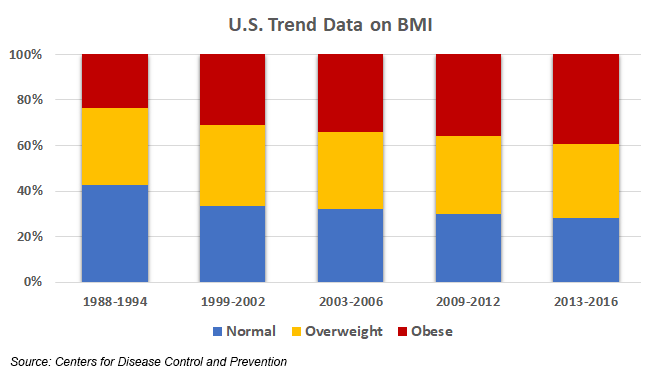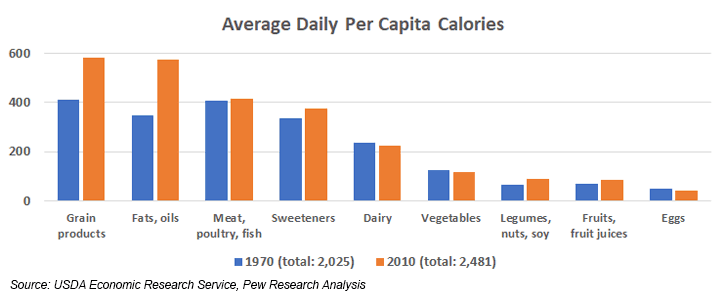For me, the start of a new year always tees up the opportunity to launch self-improvement initiatives. Diet and nutrition head this year’s list. Though I’ve read and have written quite a bit about the subject, there’s always more to learn. My guide for the next several posts will be Roberta H. Anding, MS, RD/LD, CSSD, CDE, Assistant Professor at the Baylor College of Medicine and a clinical dietician with over 30 years’ experience. She teaches an outstanding course entitled Nutrition Made Clear on Great Courses Plus (a.k.a., Wondrium).
What is this topic so important?
As a nation, we’re becoming increasingly unhealthy. According to the Centers for Disease Control, the majority of Americans are either overweight (i.e., their Body Mass Index or BMI ranges between 25 and 30) or obese (i.e., their BMI exceeds 30)… and the trend data are not heading in a favorable direction.
Excess body fat has been linked to elevated risk for heart disease, stroke, type 2 diabetes, certain types of cancer, osteoarthritis, sleep apnea, and clinical depression. Beyond the deleterious effects on the individual, these conditions result in staggeringly high medical costs.
So how did we get here?
The simple answer: We eat too much food and too much of the wrong kinds of foods.
We’ve gotten the message. According to Pew Research, 54% of us believe that we’re paying closer attention to healthy eating that we did 20 years ago; however, 58% of us think we should eat healthier most days. Mintel’s research tells us why:
- 43% of Americans believe that it’s difficult to be healthy given our modern lifestyle
- 80% believe healthy living demands sacrifice
- 40% find the health information landscape confusing
That last point bears closer examination. There is SO MUCH information about diet and nutrition out there. BusinessWire reports that the U.S. weight loss market is now worth $72 billion. That’s a whole lot of financial incentive to promulgate dietary information that may or may not reflect hard science. Anding raises warning flags for:
- Promises of quick and effective cure-alls
- Claims of miraculous breakthroughs, secret formulas, and treatments
- Bamboozling medical terminology
- Attempts to equate “all natural” with safety and efficacy
- Aggressive use of personal testimonials
- An artifice of scarcity – e.g., “limited supply,” “act now”
- Money-back guarantees
In short, if it’s too good to be true, it probably isn’t true.
There’s no substitute for going back to basics – i.e., eating a balanced diet of whole, unprocessed foods in the right amounts consistently. While it takes a bit more investment in time, I’ve learned to multi-task while preparing meals – e.g., watching TV while doing food prep, or listening to an audiobook or podcast while cooking. I’ve found ways to make healthy meals taste really good. (Just ask my husband!) And I watch portion size.
If you’d like high quality information, Anding recommends the following resources:
- American Dietetic Organization (eatright.org)
- American College of Sports Medicine (acsm.org)
- Centers for Disease Control (cdc.gov)
- Food and Drug Administration (fda.gov)
- Food and Nutrition Information Center (www.nal.usda.gov/fnic)
To that list, I would add www.NutritionFacts.org. I’ve been watching Dr. Michael Greger’s short videos for years and consistently find them well-constructed, newsworthy, and evidence-based.

